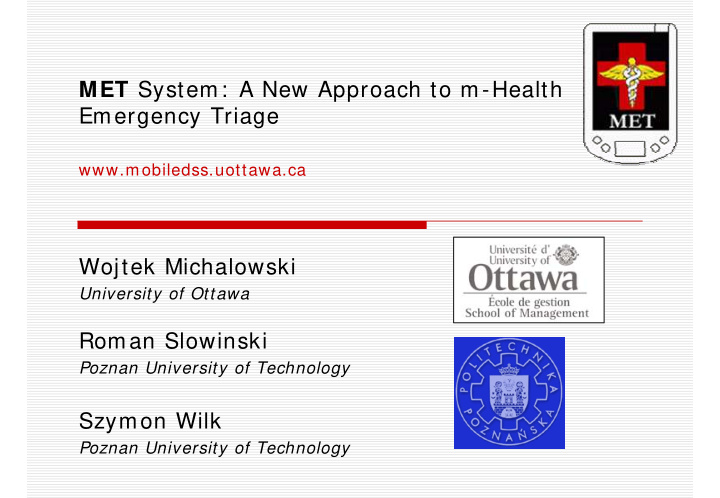



MET System: A New Approach to m-Health Emergency Triage www.mobiledss.uottawa.ca Wojtek Michalowski University of Ottawa Roman Slowinski Poznan University of Technology Szymon Wilk Poznan University of Technology
MET Project Outline From Knowledge Discovery - capturing the knowledge of the “experienced” Through Clinical Decision Support - using that knowledge to help the “inexperienced” To m-Health - bringing the support to the bedside 2
Outline Clinical workflow for the triage in the Emergency • Department (ED) Clinical DSS and m-health • MET system • Abdominal pain in children and clinical trial • 3
Assessment of a Child in the ED Prioritization (Triage nurse) Priority categories Triage Medical assessm ent and disposition (Physician) Observation/ Discharge Consult further investigation The issue: To facilitate ED triage of acute childhood conditions at the point of care 4
Clinical DSS and m-Health Clinical decision support systems (Clinical DSS): • “computer based tools using explicit knowledge to generate patient specific advice or interpretation” e-Health: providing clinical and medical advice using • communication and information technologies m-Health: providing clinical and medical advice at the • point of care using most suitable technologies 5
M obile E mergency T riage System MET is a Clinical DSS designed to assist physicians at the point of care with triage decisions as to whether a child presenting to the ED with a specific acute complaint should be discharged to the family physician, needs further investigation or observation, or requires urgent specialist consultation 6
Some Facts Retrospective chart reviews were conducted during 1993-2003 at CHEO for abdominal pain, scrotal pain, hip pain: Inductive learning was used to develop a set of clinical • rules (clinical algorithm) Clinical algorithm was verified with the medical specialists; • Mobility was introduced by implementing clients on PDAs • and tablet PCs Retrospective and prospective validation of the system was • conducted in a hospital 7
Providing Clinical Support at the Point of Care Need to rely on portable (mobile) computing devices that • can also work offline Need to have a versatile and context-aware system in • order to support complex patient management problems 8
MET Design New design: extended client-server architecture • Hospital Hospital system # 1 system # 2 Presentation Presentation modules modules HL7 Integrator Shell Interface engine HL7 HL7 Temporal Local database database EPRS MET Server MET Client 9
MET Operations (# 1) MET Server MET Client EPRS/ I nterface Engine Admission message New pateint Decode and update Triage for a patient registered the temporal database requested Observation Patient data report Synchronize Synchronize Patient data updated the temporal database the local database Required presentation modules Send required Synchronize required presentation modules presentation modules Requested presentation modules Send requested Synchronize requested presentation modules presentation modules Purge redundant presentation modules 10
MET Operations (# 2) EPRS/ I nterface Engine MET Server MET Client Admission Request for message New pateint Receive, decode and synchrionization registered store patient data Triage for a patient requested Patient data Send required Receive and store patient data patient data Presentation modules Send required Receive and store presentation modules presentation modules Data collected and updated, triage made Observation Patient data report „Hospital-wide” Receive updated Send updated patient data updated patient data patient data Purge redundant Purge redundant presentation modules patient data and patient data 11
12 Aligning with the ED Workflow MET Interactions:
13 Natural Mappings # 1 MET Interactions:
14 Natural Mappings # 2 MET Interactions:
Abdominal Pain in Children Common presenting complaint Over 3000 patient visits per year 8-10 patients/ day Other patients presenting with other complaints Time-consuming process Average arrival to assessment 60-90 minutes Average MD to disposition 150-180 minutes 55% have lab, 26% have imaging 15
Trial Design Recruit patients with acute abdominal pain presenting to • CHEO ED 24/ 7 recruitment by triage/ registration/ resident/ staff • Informed consent to collect patient data and make • follow-up telephone call Where possible – 2 independent observations by • staff/ resident or resident/ staff All clinicians blinded to MET recommendation • Patients followed until final outcome is established • 16
Trial Results • Analysis of 457 patients with complete F/ U 2x2 Consult vs Non-consult Physicians: Sens 71% , Spec 95% , Accuracy 92% MET : Sens 71% , Spec 92% , Accuracy 90% Other successes Integration with hospital IS • Structured and real-time data collection by • physicians 17
Conclusions Structured data capture Contribution to timely patient management Fit of the system to the ED workflow 18
Acknowledgements Rhonda Correll, Emergency Division Research Coordinator, CHEO Ken Farion, Division of Emergency Medicine, CHEO Greg Forestell, Information Services, CHEO John Pike, Division of Urology, CHEO Steven Rubin, Division of General Surgery, CHEO Mathieu Chiasson, MET Research Team Nataliya Milman, MET Research Team Roksana Mottahedi, MET Research Team Bernard Plouffe, MET Research Team Leticia Troppman, MET Research Team 19
Thank You Please visit us at: www.mobiledss.uottawa.ca 20
Recommend
More recommend